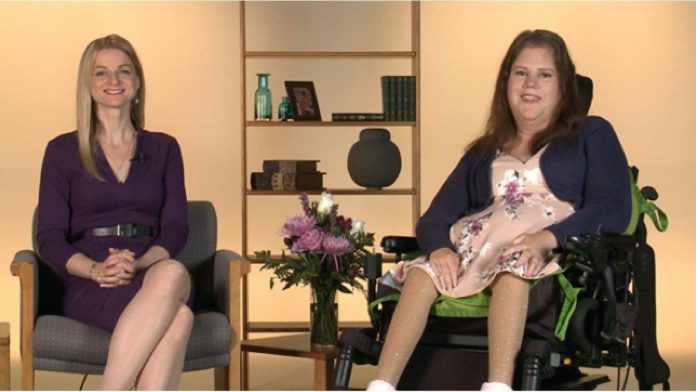(BPT) – Perseverance holds a special significance to 28-year-old Kailey McCallister. When she was nearly three years old, she was diagnosed with Type 3 spinal muscular atrophy (SMA), a rare genetic disease that causes progressive muscle weakness and a loss of strength.
There are different types of SMA, and the level of severity can vary from one individual to another. People living with SMA Type 3 may have minimal to profound weakness by the time they reach adulthood.[2] Babies with Type 1 rarely reach motor milestones and the disease can be life-threatening, while those with Type 2 are typically unable to walk and lose strength over time.[3] As Kailey was growing up, she noticed she was different from many other people because she would often fall over and had difficulty walking.
Kailey’s sister, Ashley — who was just one year younger than her — was also diagnosed with SMA, but was born with Type 1, its most severe form. At the time, there were no approved therapies for SMA and Ashley passed away at the age of six.
As she continued to grow, Kailey dedicated significant time to physical therapy with the hopes of limiting her disease progression. However, she noticed she was still losing strength.
On December 23, 2016, SPINRAZA® (nusinersen) was approved as the first therapy to treat infants, children and adults with SMA. In the spring of 2017, Kailey’s neurologist told her about SPINRAZA and the potential benefits of starting therapy.
“The information my neurologist shared with me motivated me to explore additional things I could do to help my SMA, and thinking about my sister Ashley inspired me to do all that I could,” says Kailey. “While I continue to use a power wheelchair and get support from a home health aide, treatment has helped me maintain my mobility and strength. I know Ashley would be proud of my perseverance and the commitment I have to do everything I can to treat my SMA.”
Kailey is continuing to receive SPINRAZA, which is administered intrathecally — as an injection into the lower back, through a procedure called a lumbar puncture — to help treat her SMA. The SPINRAZA dosing regimen consists of more frequent loading doses in the first year followed by maintenance doses every four months.
As part of her care, Kailey continues to visit her neurologist, Dr. Margaret Frey, a board-certified neurologist in Michigan to monitor her SMA, and check for potential side effects of treatment with blood and urine tests. Common side effects include lower respiratory infection, fever, constipation, headache, vomiting, and back pain (see below for more information).
“I am so proud of Kailey and her determination to face the challenges of this disease head-on. She has developed a great support network that has allowed her to keep a level of independence,” says Dr. Frey. “While patients have different experiences on treatment, I encourage individuals living with SMA to see a neurologist to discuss their options.”
Kailey notes, “While I have a milder version of SMA than what my sister Ashley had, this is a progressive disease that continues to get worse over time. I see the value that treatment, Dr. Frey, and my entire healthcare team have in managing my SMA.”
Kailey is sharing her story in celebration of the three-year anniversary of SPINRAZA being approved for individuals living in the United States — making December 23rd a special day for her. She hopes that by telling her story, other adults with SMA will talk with a neurologist about their ongoing care and understand their treatment options. “I am grateful for my physician and my experiences on treatment, and know that while SMA comes with challenges, I feel I am doing everything I can to try and live my life to the fullest.”
As of September 2019, more than 9,300 individuals have been treated with SPINRAZA globally, with over 2,900 adults treated in the US. [1*] Individual results may vary based on several factors, including severity of disease, initiation of treatment, and duration of therapy.
INDICATION
SPINRAZA® (nusinersen) is a prescription medicine used to treat spinal muscular atrophy (SMA) in pediatric and adult patients.
IMPORTANT SAFETY INFORMATION
Increased risk of bleeding complications has been observed after administration of similar medicines. Your healthcare provider should perform blood tests before you start treatment with SPINRAZA and before each dose to monitor for signs of these risks. Seek medical attention if unexpected bleeding occurs.
Increased risk of kidney damage, including potentially fatal acute inflammation of the kidney, has been observed after administration of similar medicines. Your healthcare provider should perform urine testing before you start treatment with SPINRAZA and before each dose to monitor for signs of this risk.
The most common side effects of SPINRAZA include lower respiratory infection, fever, constipation, headache, vomiting, back pain, and post-lumbar puncture syndrome.
These are not all of the possible side effects of SPINRAZA. Call your healthcare provider for medical advice about side effects. You may report side effects to FDA at 1-800-FDA-1088.
Before taking SPINRAZA, tell your healthcare provider if you are pregnant or plan to become pregnant.
Please visit http://bit.ly/SpinrazaPI for the Full Prescribing Information and to learn more.
This information is not intended to replace discussions with your healthcare provider.
This article is sponsored by Biogen.
References:
*Based on commercial patients in the US (including Puerto Rico) as of September 2019.1
1. Data on file, Biogen, Cambridge, MA
2. MD Australia. (2019). Spinal Muscular Atrophy Type 3 (juvenile SMA) | MD Australia. [online] Available at: https://www.mda.org.au/disorders/spinal-muscular-atrophy-an-overview/spinal-muscular-atrophy-type-3-juvenile-sma/ [Accessed 22 Aug. 2019].
3. Lefebvre S, Burglen L, Reboullet S, et al. Identification and characterization of a spinal muscular atrophy-determining gene. Cell. 1995;80(1):155-165.
SPZ-US-3026 12/19






